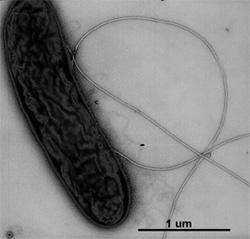Geobacter metallireducens
Template:Geobacter metallireducens

Classification
Higher order taxa
Bacteria; Proteobacteria; Delta Proteobacteria; Desulferomonadales; Geobacteraceae
Species
Geobacter metallireducens
Description and significance
Geobacter metallireducens is a rod shaped, gram negative, anaerobic bacteria and can be seen to have flagella and pili. The first G. metallireducens (initially known as strain GS-15) was first isolated from freshwater sediment, and was able to gain energy through dissimilatory reduction of iron, manganese, uranium and other metals. This organism was the first organism found to oxidize organic compounds to carbon dioxide with iron oxides as the electron acceptor (Lovely and Phillips 1988). G. metallireducens can also oxidize short chain fatty acids, alcohols, and monoaromatic compounds such as toluene and phenol using iron as its electron acceptor (Lovely et al 1993).
Genome structure
G. metallireducens contains genes for flagella synthesis. G. metallireducens was orginally thought to be immotile because they were grown in labs under ideal conditions where the bacteria had plenty of soluble metals. Synthesis for flagella do not initiate unless nutrient conditions are poor. Under conditions where soluble metals were replaced with less favorable iron oxide, G. metallireducens was seen to grow flagella and swim (Childers et al 2002). G. metallireducens also contains genes that allow the bacteria the ability of chemotaxis. Chemotaxis allows G. metallireducens to sense compounds, favorable and unfavorable, in its surrounding environment. Together with the ability to perform chemotaxis and produce and use flagella, G. metallireducens has the ability to move towards metallic compounds or favorable environments where nutrient supply is favorable and away from less favorable environments where nutrient supply is poor (Childers et al 2002).
Cell structure and metabolism
Previous experiments on bacteria that can perform electron transfer to Fe(III) have focused on the role of outer-membrane c-type cytochromes (Reguera et al 2005). However, some Fe(III) reducers lack c-cytochromes. Geobacter species are examples of such Fe(III) reducers that lack c-cytochromes and must directly contact Fe(III) oxides to reduce them (Reguera et al 2005). They produce pili that were proposed to aid in establishing contact with the Fe(III) oxides (Reguera et al 2005).
G. metallireducens favors or is chemotactic to soluble electron acceptors Fe(II) and Mn(II) and expresses flagella and pili only when grown on insoluble Fe(III) or Mn(IV) oxide (Childers et al 2002). These results suggest that G. metallireducens senses when soluble electron acceptors are depleted and will promote synthesis of flagella and pili allowing it to search for, and establish contact with, insoluble Fe(III) or Mn(IV) oxide (Childers et al 2002).
Ecology
G. metallireducens has been known to take part in bioremediation of organic and metal contaminants in groundwater and participates in the carbon and nutrient cycles of aquatic sediments. Aside from using Fe(III) oxides, the G. metallireducens uses metals such as plutonium and uranium to metabolize food. G. metallireducens consumes these radioactive elements and breaks down the contaminants. In the case of uranium, it changes the metal from a soluble to an insoluble form. The insoluble uranium drops out of the groundwater, thus decontaminating streams and drinking water. It remains in the soil and could then be extracted (Childer 2002). The use of an insoluble electron acceptor may explain why Geobacter species predominate over other Fe(III) oxide-reducing microorganisms in a wide variety of sedimentary environments.
Describe any interactions with other organisms (included eukaryotes), contributions to the environment, effect on environment, etc.
Pathology
How does this organism cause disease? Human, animal, plant hosts? Virulence factors, as well as patient symptoms.
Application to Biotechnology
In G. metallireducens' relative species, Geobacter sulfurreducens, conducting-probe atomic force microscopy revealed that the pili were highly conductive. These results indicate that the pili of G. sulfurreducens might serve as biological nanowires, transferring electrons from the cell surface to the surface of Fe(iii) oxides. Electron transfer through pili indicates possibilities for other unique cell-surface and cell-cell interactions, and for bioengineering of novel conductive materials.
Current Research
Enter summaries of the most recent research here--at least three required
References
Edited by Christine Tang student of Rachel Larsen and Kit Pogliano
